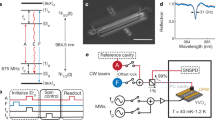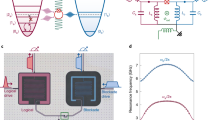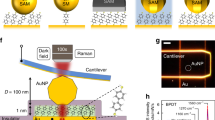Abstract
Building a scalable quantum processor requires coherent control and preservation of quantum coherence in a large-scale quantum system. Mesoscopic solid-state systems such as Josephson junctions and quantum dots feature robust control techniques using local electrical signals and self-evident scaling; however, in general the quantum states decohere rapidly. In contrast, quantum optical systems based on trapped ions and neutral atoms exhibit much better coherence properties, but their miniaturization and integration with electrical circuits remains a challenge. Here we describe methods for the integration of a single-particle system—an isolated polar molecule—with mesoscopic solid-state devices in a way that produces robust, coherent, quantum-level control. Our setup provides a scalable cavity-QED-type quantum computer architecture, where entanglement of distant qubits stored in long-lived rotational molecular states is achieved via exchange of microwave photons.
This is a preview of subscription content, access via your institution
Access options
Subscribe to this journal
Receive 12 print issues and online access
$209.00 per year
only $17.42 per issue
Buy this article
- Purchase on Springer Link
- Instant access to full article PDF
Prices may be subject to local taxes which are calculated during checkout




Similar content being viewed by others
References
Special issue on ultracold polar molecules: Formation and collisions. Eur. Phys. J. D 31, 149–444 (2004).
Loss, D. & DiVincenzo, D.P. Quantum computation with quantum dots. Phys. Rev. A 57, 120–126 (1998).
Wallraff, A. et al. Approaching unit visibility for control of a superconducting qubit with dispersive readout. Phys. Rev. Lett. 95, 060501 (2005).
Makhlin, Y., Schön, G. & Shnirmam, A. Quantum-state engineering with Josephson-junction devices. Rev. Mod. Phys. 73, 357–400 (2001).
Nakamura, Y., Pashkin, Y. & Tsai, J. Coherent control of macroscopic quantum states in a single-cooper-pair box. Nature 398, 786–788 (1999).
Folman, R., Krüger, P., Schmiedmayer, J., Denschlag, J. & Henkel, C. Microscopic atom optics: From wires to an atom chip. Adv. At. Mol. Opt. Phys. 48, 263–273 (2002).
Mandel, O. et al. Controlled collisions for multi-particle entanglement of optically trapped atoms. Nature 425, 937–940 (2003).
Cirac, J. I. & Zoller, P. New frontiers in quantum information with atoms and ions. Phys. Today 57, 38–39 (2004).
Leibfried, D. et al. Creation of a six-atom ‘Schrodinger cat’ state. Nature 438, 639–642 (2005).
Häffner, H. et al. Scalable multiparticle entanglement of trapped ions. Nature 438, 643–646 (2005).
DeMille, D. Quantum computation with trapped polar molecules. Phys. Rev. Lett. 88, 067901 (2002).
Sørensen, A. S., van der Wal, C. H., Childress, L. I. & Lukin, M. D. Capacitive coupling of atomic systems to mesoscopic conductors. Phys. Rev. Lett. 92, 063601 (2004).
Bethlem, H. L. et al. Electrostatic trapping of ammonia molecules. Nature 406, 491–494 (2000).
Rieger, T., Junglen, T., Rangwala, S. A., Pinkse, P. W. H. & Rempe, G. Continuous loading of an electrostatic trap for polar molecules. Phys. Rev. Lett. 95, 173002 (2005).
Xia, Y., Deng, L. & Yin, J. Electrostatic guiding of cold polar molecules on a chip. Appl. Phys. B 81, 459–464 (2005).
Egorov, D., Lahaye, T., Schöllkopf, W., Friedrich, B. & Doyle, J. M. Buffer-gas cooling of atomic and molecular beams. Phys. Rev. A 66, 043401 (2002).
Weinstein, J. D., deCarvalho, R., Hancox, C. I. & Doyle, J. M. Evaporative cooling of atomic chromium. Phys. Rev. A 65, 021604 (2002).
DeMille, D., Glenn, D. & Petricka, J. Microwave traps for cold polar molecules. Eur. Phys. J. D 31, 375–384 (2004).
Masuhara, N. et al. Evaporative cooling of spin-polarized atomic hydrogen. Phys. Rev. Lett. 61, 935–938 (1988).
Vuletic, V., Chan, H. W. & Black, A. T. Three-dimensional cavity Doppler cooling and cavity sideband cooling by coherent scattering. Phys. Rev. A 64, 033405 (2001).
Bochinski, J., Hudson, E. R., Lewandowski, H., Meijer, G. & Ye, J. Phase space manipulation of cold free radical OH molecules. Phys. Rev. Lett. 91, 243001 (2003).
Wallraff, A. et al. Strong coupling of a single photon to a superconducting qubit using circuit quantum electrodynamics. Nature 431, 162–167 (2004).
Blais, A., Huang, R.-S., Wallraff, A., Girvin, S. M. & Schoelkopf, R. J. Cavity quantum electrodynamics for superconducting electrical circuits: An architecture for quantum computation. Phys. Rev. A 69, 062320 (2004).
Scully, M. & Zubairy, M. S. Quantum Optics (Cambridge Univ. Press, Cambridge, 1997).
Day, P. K. et al. A broadband superconducting detector suitable for use in large arrays. Nature 425, 817–821 (2003).
Frunzio, L., Wallraff, A., Schuster, D., Majer, J. & Schoelkopf, R. Fabrication and characterization of superconducting circuit QED devices for quantum computation. IEEE Trans. Appl. Supercond. 15, 860–863 (2005).
Raimond, J. M. et al. Probing a quantum field in a photon box. J. Phys. B 38, S535–S550 (2005).
Miller, R. et al. Trapped atoms in cavity QED: Coupling quantized light and matter. J. Phys. B 38, S551–S565 (2005).
Wineland, D. J. & Itano, W. M. Laser cooling of atoms. Phys. Rev. A 20, 1521–1540 (1979).
Deslauriers, L. et al. Zero-point cooling and low heating of trapped 111Cd+ ions. Phys. Rev. A 70, 043408 (2004).
Zorin, A. et al. Background charge noise in metallic single-electron tunneling devices. Phys. Rev. B 53, 13682–13687 (1996).
Turchette, Q. A. et al. Heating of trapped ions from the quantum ground state. Phys. Rev. A 61, 063418 (2000).
Astafiev, O., Pashkin, Y. A., Nakamura, Y., Yamamoto, T. & Tsai, J. Quantum noise in the Josephson charge qubit. Phys. Rev. Lett. 93, 267007 (2004).
Schriefl, J., Makhlin, Y., Shnirman, A. & Schoen, G. Decoherence from ensembles of two-level fluctuators. New J. Phys. 8, 001 (2006).
Cirac, J. I. & Zoller, P. Quantum computation with cold trapped ions. Phys. Rev. Lett. 74, 4091–4094 (1995).
Kielpinski, D., Monroe, C. & Wineland, D. J. Architecture for a large-scale ion-trap quantum computer. Nature 417, 709–711 (2002).
Steane, A. Overhead and noise threshold of fault-tolerant quantum error correction. Phys. Rev. A 68, 042322 (2003).
Rabl, P. et al. Hybrid quantum processors: molecular ensembles as quantum memory for solid state circuits. Phys. Rev. Lett. 97, 033003 (2006).
Lukin, M. D. Colloquium: Trapping and manipulating photon states in atomic ensembles. Rev. Mod. Phys. 75, 457–472 (2003).
Sachdev, S. Quantum Phase Transitions (Cambridge Univ. Press, New York, 1999).
Troppmann, U., Tesch, C. M. & de Vivie-Riedle, R. Preparation and addressability of molecular vibrational qubit states in the presence of anharmonic resonance. Chem. Phys. Lett. 378, 273–280 (2003).
Babikov, D. Accuracy of gates in a quantum computer based on vibrational eigenstates. J. Chem. Phys. 121, 7577–7585 (2004).
Yelin, S. F., Kirby, K. & Côté, R. Schemes for robust quantum computation with polar molecules. Preprint at <http://xxx.lanl.gov/abs/quant-ph/0602030> (2006).
Cirac, J. I., Blatt, R., Zoller, P. & Phillips, W. D. Laser cooling of trapped ions in a standing wave. Phys. Rev. A 46, 2668–2681 (1992).
Lin, Y., Teper, I., Chin, C. & Vuletic, V. Impact of the Casimir-Polder potential and Johnson noise on Bose-Einstein condensate stability near surfaces. Phys. Rev. Lett. 92, 050404 (2004).
Brown, J. M. & Carrington, A. Rotational Spectroscopy of Diatomic Molecules (Cambridge Univ. Press, New York, 2003).
Childs, W. J., Cok, D. R., Goodman, G. L. & Goodman, L. S. Hyperfine and spinrotational structure of CaBr X 2Σ(v=0) by molecular-beam laser-rf double resonance. J. Chem. Phys. 75, 501–507 (1981).
Acknowledgements
We thank T. Calarco, L. Childress, A. Sorensen and J. Taylor for helpful discussions. Work at Harvard is supported by NSF, Harvard-MIT CUA and Packard and Sloan Foundations. Work at Yale is supported by NSF Grant DMR0325580, the W.M. Keck Foundation and the Army Research Office. Work at Innsbruck is supported by the Austrian Science Foundation, European Networks and the Institute for Quantum Information. J.M.D. would like to thank the Humboldt Foundation and G. Meijer for their support.
Author information
Authors and Affiliations
Corresponding author
Ethics declarations
Competing interests
The authors declare no competing financial interests.
Supplementary information
Rights and permissions
About this article
Cite this article
André, A., DeMille, D., Doyle, J. et al. A coherent all-electrical interface between polar molecules and mesoscopic superconducting resonators. Nature Phys 2, 636–642 (2006). https://doi.org/10.1038/nphys386
Received:
Accepted:
Published:
Issue Date:
DOI: https://doi.org/10.1038/nphys386
This article is cited by
-
Simulation of EOM-based frequency-chirped laser slowing of MgF radicals
Frontiers of Physics (2022)
-
Saturated absorption spectroscopy of buffer-gas-cooled Barium monofluoride molecules
Frontiers of Physics (2022)
-
Tuning of dipolar interactions and evaporative cooling in a three-dimensional molecular quantum gas
Nature Physics (2021)
-
Dipolar evaporation of reactive molecules to below the Fermi temperature
Nature (2020)
-
Rotational coherence of encapsulated ortho and para water in fullerene-C60 revealed by time-domain terahertz spectroscopy
Scientific Reports (2020)



